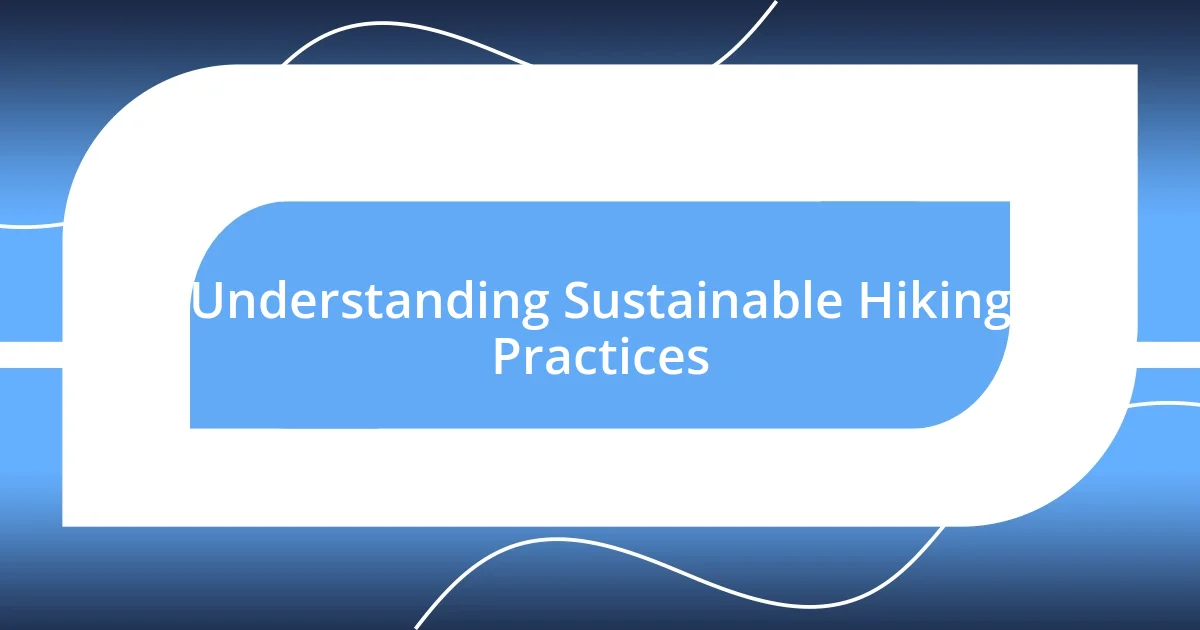Key takeaways:
- Sustainable hiking practices prioritize minimizing environmental impact, following the Leave No Trace principles, and fostering a connection to local ecosystems.
- Preparation for a sustainable hike includes researching trails, choosing eco-friendly gear, and packing minimally to reduce waste.
- Conserving water and energy on hikes enhances the experience and preserves nature, highlighting the importance of mindful pacing and proper planning.

Understanding Sustainable Hiking Practices
Sustainable hiking practices revolve around minimizing our impact on the environment while enjoying the beauty of nature. I often find myself reflecting on moments when I’ve noticed the devastating effects of litter in pristine landscapes, and it motivates me to do better. Have you ever seen a beautiful view spoiled by trash? It’s a stark reminder of how our actions can ripple through ecosystems.
One essential element of sustainable hiking is following the Leave No Trace principles. These guidelines, which encourage you to pack out what you pack in, resonate with me deeply. For instance, on my last hike, I made it a point to carry a small trash bag for any waste I came across, even if it wasn’t mine. This simple act not only kept the trail clean but also connected me with fellow hikers who shared the same commitment. It’s amazing how small efforts can lead to a collective impact.
Understanding the local ecosystem also plays a crucial role in sustainable hiking. When I hike, I take time to learn about the flora and fauna, and this makes my experience all the richer. Have you ever stopped to admire a unique plant or bird? Recognizing these elements not only fosters appreciation but also emphasizes the importance of preserving these habitats for the future. Each hike becomes a lesson in stewardship, deepening my connection to the natural world.

Preparing for Sustainable Hikes
Preparing for a sustainable hike starts long before you hit the trail. I remember the excitement of planning my first big hike, only to realize I hadn’t considered the environmental impact of my choices. It’s vital to research your destination, understanding not just the best routes, but also the local regulations and wildlife. Knowing you’re respecting the area makes a hike feel even more fulfilling.
Here are some tips to ensure your hike is sustainable:
- Research the trail and terrain for any specific guidelines.
- Choose eco-friendly gear, like biodegradable soap and reusable utensils.
- Pack only the essentials to minimize waste and weight.
- Bring a refillable water bottle and water purification system.
- Wear appropriate footwear to protect the land and your feet.
- Plan your meals carefully, favoring local and minimal packaging options.
- Share your plan with someone, promoting safety and accountability.
Having these tips in mind can transform not just your preparation but also enhance your experience in nature, creating a deeper bond with the environment as you hike. Each choice, no matter how small, contributes to the well-being of our trails.

Choosing Eco-Friendly Hiking Gear
Choosing eco-friendly hiking gear can significantly impact your experience and the environment. I’ve learned that when I’m mindful about the equipment I select, it not only helps to reduce my carbon footprint but also enhances my enjoyment of the journey. For example, on one hike, I swapped out my old backpack for one made from recycled materials. It felt great to think that I was contributing to sustainability while carrying my gear comfortably.
I often think about how crucial it is to choose durable and high-quality gear. Investing in such items may seem more expensive upfront, but they last much longer. This mindset shifted during a hike where my friend opted for cheap, disposable gear that broke halfway through. Watching her struggle made me realize that quality gear not only performs better, but it also reduces waste over time. Have you ever faced a similar situation, where investing wisely paid off in the longer run?
Additionally, I recommend checking for certifications when shopping for hiking gear. Brands that are committed to sustainable practices often have eco-labels or certifications that indicate their products meet environmental standards. For instance, I stumbled upon a company certified by the Global Organic Textile Standard while looking for hiking clothing. Knowing my choices are backed by reliable measures helps me feel more connected to my gear and its impact on the planet.
| Gear Type | Eco-Friendly Options |
|---|---|
| Backpacks | Made from recycled plastics |
| Footwear | Sustainable materials and production processes |
| Clothing | Organic cotton, hemp, or recycled fabrics |
| Sleeping Gear | Natural insulation and non-toxic materials |

Respecting Wildlife and Nature
Respecting wildlife is a core part of sustainable hiking that I’ve come to appreciate deeply. I’ve seen animals thrive in their natural habitats when hikers make the effort to keep a respectful distance. On one memorable hike, I spotted a deer gracefully moving through the trees, and rather than approaching for a closer look, I admired it from afar. Moments like these remind me to be mindful of my presence; after all, observing from a distance minimizes stress on wildlife and allows them to continue their routines undisturbed.
When it comes to nature, our actions can leave a lasting impact. I recall a time when I wandered off the trail to get a better view of a stunning waterfall. Later, I learned that my shortcut damaged delicate vegetation and disturbed the habitat. This experience taught me the importance of sticking to established paths. Have you ever considered how a single footstep can ripple through an ecosystem? Each trail we follow helps preserve the surrounding wildlife, making it vital to tread carefully.
One principle that guides me in my hikes is to leave no trace—an idea that encompasses both the physical and emotional aspects of our journey. I often carry out any trash I find along the way, feeling a sense of responsibility to help maintain the beauty of the trails. It’s a small gesture, but it ignites a sense of community with fellow hikers. Do you remember a time when you felt that same connection through a shared commitment to protecting nature? Each one of us can make a difference, and that thought inspires me to hike with intention.

Minimizing Waste While Hiking
Minimizing waste while hiking is something I take to heart, and it can really transform the experience. I always pack my own reusable water bottle instead of grabbing single-use plastic bottles, which not only keeps me hydrated but also reduces waste. I vividly remember one hike when I forgot my bottle and had to buy water in plastic; it nagged at me throughout the trip, knowing I wasn’t living up to my values.
When it comes to snacks, I prefer to carry goodies in reusable containers or bags. I’ve discovered that I enjoy trail mix far more when it’s stored in a glass jar rather than a plastic bag. One hike with friends left a lasting impression on me; someone opened a bag of chips and a gust of wind sent the wrappers flying. It made me realize how easily waste can accumulate, so I’ve made it a point to be proactive about my choices.
Lastly, I’ve learned that planning my route can minimize waste too. I like to map out my hikes so that I can take shorter trips with less need for extra gear. A few months ago, an impromptu decision to hike a longer trail meant I had to carry all my gear for the day—and extras that I didn’t even use! That taught me the importance of being prepared without overpacking. What are some of your strategies for keeping waste to a minimum on your hikes? Each conscious choice can truly make a difference in how we enjoy and protect our outdoor spaces.

Following Leave No Trace Principles
Following the Leave No Trace principles has truly reshaped how I approach the outdoors. I remember a time when I was hiking in a pristine forest, and I stumbled upon an area strewn with litter. The feeling of disappointment was palpable. It hit me hard that our actions can define the trails for future visitors. I’ve since adopted a practice of leaving any place I visit in better condition than I found it. Have you ever experienced that rewarding sense of accomplishment when picking up stray trash? It’s a small act, yet it resonates on a much larger scale.
Adhering to the Leave No Trace principles means being considerate about the environments we traverse. A few years back, I attended a workshop focused on these principles, and one guiding concept that struck me was the idea of minimizing campfire impacts. I recall a camping trip where we opted for a portable stove over a campfire for cooking. The experience was surprisingly enjoyable, and it eased my worries about affecting the surrounding vegetation. It made me question: how much more can we enjoy nature without leaving a lasting mark?
Teaching others about Leave No Trace has become a passion of mine. I recently led a youth hiking group, eager to share these principles. Watching them embrace the values of respecting wildlife and sticking to trails was incredibly fulfilling. It was a simple conversation about the importance of preserving our natural world, but the impact was profound. How do you share your commitment to responsible hiking with others? Knowing I’m inspiring the next generation of outdoor enthusiasts fills me with hope for our collective future.

Conserving Water and Energy
Conserving water during hikes is something I take seriously, especially after a trip where I underestimated my needs. During a particularly hot summer hike, I found myself rationing the last few sips of water in my bottle, all while watching the landscape around me become parched. That experience taught me the necessity of careful planning and bringing just enough water to sustain me while also being mindful of usage—sometimes, I’ll even fill up at streams or lakes along the way if it’s safe to do so, which helps reduce the amount I carry.
When it comes to energy conservation, I’ve found that pacing myself can make a world of difference. On my first long hike, I was eager to reach the summit and pushed hard, only to feel utterly drained halfway up. Now, I intentionally pace myself, taking breaks to rest and enjoy the scenery. This approach not only saves my energy but also enhances my overall hiking experience. Have you ever noticed how a slower, more mindful pace allows you to absorb the beauty around you instead of merely rushing to the finish line?
Lastly, I believe in the power of nature’s rhythms. On a recent hike, I decided to start later in the day to minimize my energy consumption in the heat. The low angle of the sun created stunning lighting, and I was fortunate enough to see wildlife awakening as I strolled quietly along the trail. It made me wonder: how often do we rush our outdoor experiences when we could be enjoying the journey just as much? By syncing our activities with nature’s natural patterns, we not only conserve our own energy but also deepen our connection to the environment we cherish.














